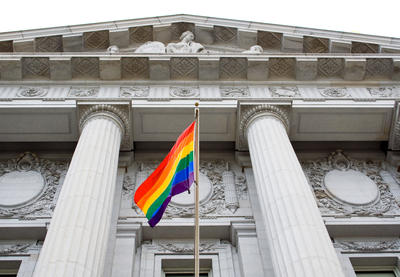“It is my life,” Aimee Stephens told an interviewer in January. “But it’s also a lot of other people’s lives.”
Stephens died in May, seven years after she’d been fired from her job because she was a trans woman—and just a mere five weeks before the Supreme Court would decide if the callous treatment of her life, and of a lot of other people’s lives, was an injustice.
Gerald Bostock was one of three plaintiffs—alongside the late Stephens and the late Donald Zarda—whose firings fell before the court. Zarda died in 2014, a loss that reminds us how long these individual injustices have been tied up in the courts. Bostock was the only surviving plaintiff who got to witness the fruit of that struggle.
On June 15, 2020, the Supreme Court offered their ruling in the landmark case Bostock v. Clayton County, GA. Near the end of the court’s 33-page opinion, written by Justice Neil Gorsuch and joined by Chief Justice John Roberts and Justices Ruth Bader Ginsburg, Sonia Sotomayor, Elena Kagan and Stephen Breyer, was a simple sentence with profound consequences:
“An employer who fires an individual merely for being gay or transgender defies the law.”
The court had ruled that Title VII of the Civil Rights Act protected trans and gay employees from workplace discrimination.
The 6-3 decision was initially met with two words from Stephens’ wife, Donna: “We won.” We won.
It is a long-fought victory for the LGBTQ liberation movement, for those who fought, protested and bled for the Civil Rights Act, and for Black and brown liberation movements that for too long have been denied protections for queer Black and brown workers. A historic ruling, Bostock is a testament to the righteous disruption from every single person who chose to demand full dignity and humanity in their workplaces.
To help us contextualize this ruling and what it means for LGBTQ educators and students, we spoke with Scott McCoy, interim Deputy Legal Director for the Southern Poverty Law Center’s LGBTQ Rights practice group.
First, can you briefly explain the reality many LGBTQ educators faced before this ruling? What protections were lacking?
Prior to the Supreme Court’s landmark ruling in Bostock, whether the law protected LGBTQ educators depended on where they lived.
Before Bostock, the employment nondiscrimination framework was a complicated patchwork of local and state laws and a mixed bag of conflicting federal court interpretations of Title VII of the Civil Rights Act of 1964, the federal statute prohibiting employment discrimination. On top of that, school districts also have differing policies on nondiscrimination.
According to the Movement Advancement Project, only 21 states, the District of Columbia, Puerto Rico and Guam have laws that explicitly prohibit employment discrimination on the basis of sexual orientation and gender identity. That means that more than half (52%) of LGBTQ people in the U.S. live in jurisdictions where, before Bostock, they could face discrimination in employment based on their sexual orientation or gender identity without legal recourse.
How does this ruling change things?
This case is slightly different than other landmark gay rights cases like Romer v. Evans, Lawrence v. Texas, United States v. Windsor, and Obergefell v. Hodges. Those cases involved the recognition and vindication of the constitutional rights of LGBTQ people. ...
In this case, the Supreme Court found that the nation’s most significant civil rights law also applies to LGBTQ people. ... Title VII’s prohibition on discrimination based on sex now unequivocally includes sexual orientation and gender identity.
In the post-Bostock world, most LGBTQ educators working for public schools and non-religious charter and private schools (those with more than 15 employees) are protected by Title VII. This ruling makes it illegal under federal law everywhere in the United States for school districts to discriminate against LGBTQ educators in employment. ...
In other words, the Supreme Court threw out the patchwork and put us all under the Title VII blanket. This means that someone who is not hired or is fired or is denied a promotion, etc. because they are LGBTQ may file a complaint with the Equal Employment Opportunity Commission (EEOC). The EEOC may take up the matter against the employer itself or authorize the person to file a federal lawsuit themselves, depending on the circumstances.
The extension of these protections to LGBTQ people, especially LGBTQ youth entering the workforce, comes just in time, given the economic fallout from the ongoing pandemic. COVID-19 has resulted in high unemployment rates, and recent layoffs have disproportionately affected LGBTQ people. For young people starting out, anti-LGBTQ bias makes it even harder to compete for scarce opportunities. Hopefully, with this ruling, LGBTQ people will be on a more level playing field as they compete for employment.
The current administration has issued guidance that removes some important protections for LGBTQ people. How did this decision affect that?
While Bostock only dealt with the use and meaning of “sex” for purposes of Title VII, there are good arguments to be made and legal precedents to support a similar interpretation in other civil rights statutes.
“Sex” appears in many other civil rights and nondiscrimination laws, including the Affordable Care Act and Title IX of the Education Act Amendments of 1972 as a ground or basis on which discrimination is prohibited. The courts have often interpreted those uses of the word “sex” in Title IX to be consistent with Title VII. The same would be true for Section 1557 of the Affordable Care Act, which prohibits discrimination in the healthcare context.
So while the issues will be litigated in the years to come, it is not a stretch to think that Title IX’s and Section 1557’s prohibition of discrimination on the basis of sex also will be interpreted to prohibit sexual orientation and gender identity discrimination in education and healthcare. Such an interpretation by the courts would supersede any rules to the contrary from the Trump administration.
How might this lead to more affirming schools?
While it may take time to change workplace cultures in some parts of the country, this ruling should make LGBTQ people feel more comfortable living and working openly. Hopefully, educators will no longer feel the need to remain closeted to their students and co-workers for fear of losing their jobs. ...
Eliminating the fear of losing one’s job may allow LGBTQ educators to be more willing to sponsor a GSA, the establishment of which can be hugely important for LGBTQ students, or to stand up to their administrations in certain cases involving proms and yearbook photos.
This ruling could also mean that more and more school districts will take the affirmative step of incorporating sexual orientation and gender identity into the nondiscrimination portions of their official school district policies.



0 COMMENTS